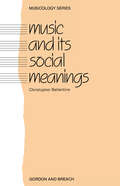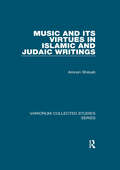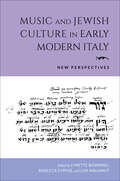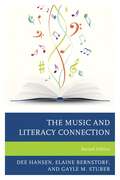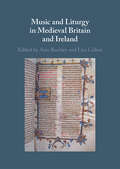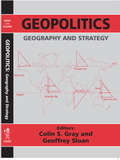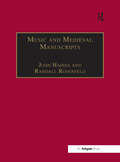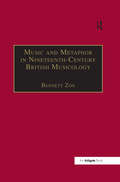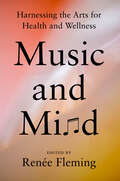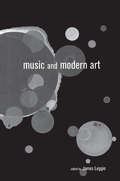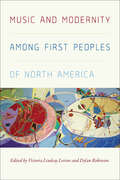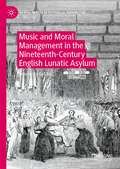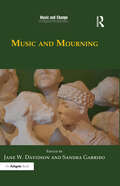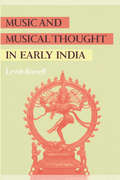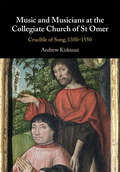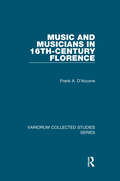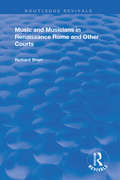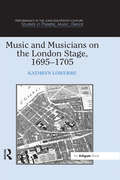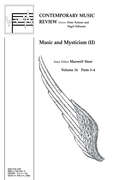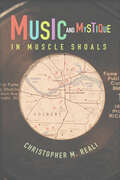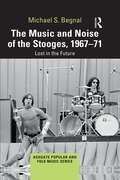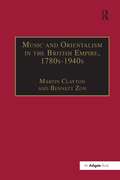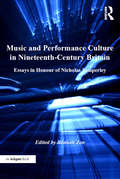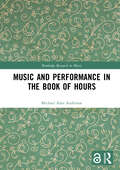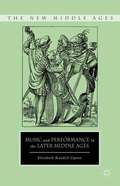- Table View
- List View
Music and Its Social Meanings (Musicology #2)
by Christopher BallantineFirst Published in 1984. Routledge is an imprint of Taylor & Francis, an informa company.
Music and its Virtues in Islamic and Judaic Writings (Variorum Collected Studies #875)
by Amnon ShiloahA fascinating aspect of the study of music in medieval Islamic and Judaic writings is the broad and interdisciplinary nature of the works and treatises in which it is covered. In addition, such works verbalize an art that was transmitted orally and took shape spontaneously, typically with improvisation during performance. As a result of this outlook the musical concept (or science) is often intertwined with practice (or history). This second collection by Amnon Shiloah brings together twenty-two studies exemplifying such multi-faceted viewpoints on the world of sounds and its virtue. The first studies concern the origin and originators of music and to how its essential constituents came into being; included here is the art of dance along with the controversial attitudes towards it. Next comes the symbolic, philosophical and metaphorical interpretation of music; one of the major ideas epitomizing this approach claimed that the pursuit of knowledge is the path to human perfection and happiness. There follow studies on the transmission of knowledge, along with some annotated key works dealing with therapeutic effects. The last articles focus on cultural traditions elaborated on European soil developing a particular style and musical practice, centred on the Iberian Peninsula, which was the scene of one of the most fascinating examples of cultural interchange.
Music and Jewish Culture in Early Modern Italy: New Perspectives (Music and the Early Modern Imagination)
by Dongmyung Ahn Aaron Beck Bonnie J. Blackburn Avery Gosfield Stefano Patuzzi Luigi Sisto Francesco Spagnolo J. Drew StephenMusical culture in Jewish communities in early modern Italy was much more diverse than researchers originally thought. An interdisciplinary reassessment, Music and Jewish Culture in Early Modern Italy evaluates the social, cultural, political, economic, and religious circumstances that shaped this community, especially in light of the need to recognize individual experiences within minority populations. Contributors draw from rich materials, topics, and approaches as they explore the inherently diverse understandings of music in daily life, the many ways that Jewish communities conceived of music, and the reception of and responses to Jewish musical culture. Highlighting the multifaceted experience of music within Jewish communities, Music and Jewish Culture in Early Modern Italy sheds new light on the place of music in complex, previously misunderstood environments.
The Music And Literacy Connection
by Dee Hansen Elaine Bernstorf Gayle M. StuberThe second edition of The Music and Literacy Connection expands our understanding of the links between reading and music by examining those skills and learning processes that are directly parallel for music learning and language arts literacy in the pre-K, elementary, and secondary levels. This edition includes two new chapters: one dedicated to secondary music education and teacher evaluation, and another that offers a literature review of latest literacy research in education, neuroscience, and neuropsychology. Readers will find extensive instructional examples for music and reading teachers so that they may enrich and support each other in alignment with current initiatives for twenty-first-century curricula. Instructional examples are aligned with The National Core Music Standards and the Common Core State Standards for English Language Arts and Media Arts. Readers will find an in-depth review of the benefits of music learning in the listening, viewing, speaking and writing literacy as well as comprehensive information for children with special needs. The Music and Literacy Connection is a valuable resource for professional development, college literacy courses, and curriculum administrators.
Music and Liturgy in Medieval Britain and Ireland
by Ann Buckley Lisa ColtonFrom music written in praise of Irish, Scottish, Welsh, and English saints to the selection of Gospel readings by the Dominicans, this book introduces readers to the richness of medieval liturgical culture from across Britain and Ireland. Each of its three main sections opens with a chapter that offers a contextual frame for its key themes. With contributions from leading experts in pre-Reformation music and its sources, the book's focus on Insular liturgy – rather than that of only one part of Britain or Ireland – allows readers to learn about the devotional, political and creative networks at play in shaping liturgical practices: personal, secular, monastic, lay, and professional. The opening part includes broader discussions of Uses, including that of Salisbury, and case studies explore Insular witnesses to devotional activities in honour of both local cults and widely known figures, including St Columba, St Margaret, St Katherine, and the Magi.
Music and Marx: Ideas, Practice, Politics (Critical and Cultural Musicology)
by Regula Burckhardt QureshiFirst Published in 2002. Routledge is an imprint of Taylor & Francis, an informa company.
Music and Medieval Manuscripts: Paleography and Performance
by Randall RosenfeldThe interdisciplinary approach of Music and Medieval Manuscripts is modeled on the work of the scholar to whom the book is dedicated. Professor Andrew Hughes is recognized internationally for his work on medieval manuscripts, combining the areas of paleography, performance, liturgy and music. All these areas of research are represented in this collection with an emphasis on the continuity between the physical characteristics of medieval manuscripts and their different uses. Albert Derolez provides a landmark and controversial essay on the origins of pre-humanistic script, while Margaret Bent proposes a new interpretation of a famous passage from a fifteenth-century poem by Martin Le Franc. Timothy McGee contributes an innovative essay on late-medieval music, text and rhetoric. David Hiley discusses musical changes and variation in the offices of a major saint‘s feast, and Craig Wright presents an original study of Guillaume Dufay. Jan Ziolkowski treats the topic of neumed classics, an under-explored aspect of the history of medieval pedagogy and the transmission of texts. The essays that comprise this volume offer a unique focus on medieval manuscripts from a wide range of perspectives, and will appeal to musicologists and medievalists alike.
Music and Metaphor in Nineteenth-Century British Musicology (Music In Nineteenth-century Britain Ser.)
by Bennett Zon�In a word, I shall endeavour to show how our music, having been originally a shell-fish, with its restrictive skeleton on the outside and no soul within, has been developed by the inevitable laws of evolution, through natural selection and the survival of the fittest, into something human, even divine, with the strong, logical skeleton of its science inside, the fair flesh of God-given beauty outside, and the whole, like man himself, animated by a celestial, eternal spirit....� W.J. Henderson, The Story of Music (1889) Critical writing about music and music history in nineteenth-century Britain was permeated with metaphor and analogy. Music and Metaphor examines how over-arching theories of music history were affected by reference to various figurative linguistic templates adopted from other disciplines such as art, religion, politics and science. Each section of the book discusses a wide range of musicological writings and their correspondence with the language used to convey contemporary ideas such as the sublime, the ancient and modern debate, and, in particular, the theory of evolution. Bennett Zon reveals that through their application of metaphorical frameworks taken from art, religion and science, these writers and their work shed light on nineteenth-century perceptions of music history and illuminate the ways in which these disciplines affected notions of musical development.
Music and Mind: Harnessing the Arts for Health and Wellness
by Edited by Renée Fleming"This book inspires us all to immerse ourselves in the vast potential of music and other creative arts to heal our wounds, sharpen our minds, enliven our bodies, and restore our broken connections.&” —Bessel van der Kolk, #1 New York Times bestselling author of The Body Keeps the ScoreWorld-renowned soprano and arts/health advocate Renée Fleming curates a collection of essays from leading scientists, artists, creative arts therapists, educators, and healthcare providers about the powerful impacts of music and the arts on health and the human experienceChapters include: Ann Patchett, &“How to Fall in Love with Opera&” Yo-Yo Ma, &“Nature, Culture, and Healing&”Aniruddh D. Patel, &“Musicality, Evolution, and Animal Responses to Music&”Richard Powers, &“The Parting Glass"Daniel J. Levitin, &“What Does It Mean to be Musical?&” Anna Deavere Smith, &“Healing Arts&” Rosanne Cash, &“Rabbit Hole&” Rhiannon Giddens, &“How Music Shows Us What It Means to Be Human&”Robert Zatorre, &“Musical Enjoyment and the Reward Circuits of the Brain&”Concetta Tomaino, &“Music and Memory&”A compelling and growing body of research has shown music and arts therapies to be effective tools for addressing a widening array of conditions, from providing pain relief andalleviating anxiety and depression to regaining speech after stroke or traumatic brain injury, and improving mobility for people with disorders that include Parkinson&’s disease and MS.In Music and Mind Renée Fleming draws upon her own experience as an advocate to showcase the breadth of this booming field, inviting leading experts to share their discoveries. In addition to describing therapeutic benefits, the book explores evolution, brain function, childhood development, and technology as applied to arts and health.Much of this area of study is relatively new, made possible by recent advances in brain imaging, and supported by theNational Institutes of Health, major hospitals, and universities. This work is sparking an explosion of public interest in the arts and health sector.Fleming has presented on this material in over fifty cities across North America, Europe, and Asia, collaborating with leading researchers, policy-makers, and practitioners. With essays from notable musicians, writers, and artists, as well as leading neuroscientists, Music and Mind is a groundbreaking book, the perfect introduction and overview of this exciting new field.
Music and Modern Art (Border Crossings)
by James LeggioMusic and Modern Art adopts an interdisciplinary approach to the relationship between these two fields of creative endeavor.
Music and Modernity among First Peoples of North America (Music / Culture Ser.)
by Victoria Lindsay Levine Dylan RobinsonMusic and Modernity among First Peoples of North America is a collaboration between Indigenous and settler scholars from both Canada and the United States. The contributors explore the intersections between music, modernity, and Indigeneity in essays addressing topics that range from hip-hop to powwow, and television soundtracks of Native Classical and experimental music. Working from the shared premise that multiple modernities exist for Indigenous peoples, the authors seek to understand contemporary musical expression from Native perspectives and to decolonize the study of Native American/First Nations music. The essays coalesce around four main themes: innovative technology, identity formation and self-representation, political activism, and translocal musical exchange. Closely related topics include cosmopolitanism, hybridity, alliance studies, code-switching, and ontologies of sound. Featuring the work of both established and emerging scholars, the collection demonstrates the centrality of music in communicating the complex, diverse lived experience of Indigenous North Americans in the twenty-first century and brings ethnomusicology into dialogue with critical Indigenous studies.
Music and Moral Management in the Nineteenth-Century English Lunatic Asylum (Mental Health in Historical Perspective)
by Rosemary GoldingThis book traces the role played by music within asylums, the participation of staff and patients in musical activity, and the links drawn between music, health, and wellbeing. In the first part of the book, the author draws on a wide range of sources to investigate the debates around moral management, entertainment, and music for patients, as well as the wider context of music and mental health. In the second part, a series of case studies bring to life the characters and contexts involved in asylum music, selected from a range of public and private institutions. From asylum bands to chapel choirs, smoking concerts to orchestras, the rich variety of musical activity presents new perspectives on music in everyday life. Aspects such as employment practices, musicians’ networks and the purchase and maintenance of musical instruments illuminate the ‘business’ of music as part of moral management. As a source of entertainment and occupation, a means of solace and self-control, and as a device for social gatherings and contact with the outside world, the place of music in the asylum offers valuable insight into its uses and meanings in nineteenth-century England.
Music and Mourning (Music and Change: Ecological Perspectives)
by Sandra Garrido Jane W. DavidsonWhile grief is suffered in all cultures, it is expressed differently all over the world in accordance with local customs and beliefs. Music has been associated with the healing of grief for many centuries, with Homer prescribing music as an antidote to sorrow as early as the 7th Century BC. The changing role of music in expressions of grief and mourning throughout history and in different cultures reflects the changing attitudes of society towards life and death itself. This volume investigates the role of music in mourning rituals across time and culture, discussing the subject from the multiple perspectives of music history, music psychology, ethnomusicology and music therapy.
Music and Musical Thought in Early India
by Lewis RowellOffering a broad perspective of the philosophy, theory, and aesthetics of early Indian music and musical ideology, this study makes a unique contribution to our knowledge of the ancient foundations of India's musical culture. Lewis Rowell reconstructs the tunings, scales, modes, rhythms, gestures, formal patterns, and genres of Indian music from Vedic times to the thirteenth century, presenting not so much a history as a thematic analysis and interpretation of India's magnificent musical heritage. In Indian culture, music forms an integral part of a broad framework of ideas that includes philosophy, cosmology, religion, literature, and science. Rowell works with the known theoretical treatises and the oral tradition in an effort to place the technical details of musical practice in their full cultural context. Many quotations from the original Sanskrit appear here in English translation for the first time, and the necessary technical information is presented in terms accessible to the nonspecialist. These features, combined with Rowell's glossary of Sanskrit terms and extensive bibliography, make Music and Musical Thought in Early India an excellent introduction for the general reader and an indispensable reference for ethnomusicologists, historical musicologists, music theorists, and Indologists.
Music and Musicians at the Collegiate Church of St Omer: Crucible of Song, 1350–1550
by Andrew KirkmanMusic played an exceptionally important role in the late Middle Ages - articulating people's social, psychological and eschatological needs. The process began with the training of choirboys whose skill was key to institutional identity. That skill was closely cultivated and directly sought by kings and emperors, who intervened directly in recruitment of choirboys and older singers in order to build and articulate their self-image and perceived status. Using the documentation of an exceptionally well preserved archive, this book focuses on music's functioning in an important church in late Medieval Northern France. It explores a period when musicians from this region set the agenda across Europe, developing what is still some of the most sophisticated music in the Western musical tradition. The book allows a close focus not on the great achievements of those who cultivated this music, but on the personal motivations that shaped their life and work.
Music and Musicians in 16th-Century Florence (Variorum Collected Studies)
by Frank A. D’AcconeThis second selection of studies by Frank D’Accone, again based principally on the documentary evidence, follows the development through the mid 16th century of musical chapels at the Cathedral and the Baptistery of Florence and of musical establishments at the Santissima Annunziata and San Lorenzo. The lives, careers and works of composers associated with these churches are illustrated and their works analyzed, particularly the theoretical treatise by Fra Mauro, the madrigals of Mauro Matti and the ambitiously conceived canzone cycle of Mattia Rampollini. The final studies, moving into the 17th century, look at the music for Holy Week, and the unprecedented programme of performances at Santa Maria Novella.
Music and Musicians in Renaissance Rome and Other Courts (Routledge Revivals)
by Richard SherrFirst published in 1999, the essays that follow have been selected from the author’s writings to explore musical institutions in 15th and 16th century Italy with a detailed focus on the papal choir, but with additional comments on Mantua (Mantova), Florence and France. Much of the material which formed the basis of those essays was largely drawn from archives. Richard Sherr explores diverse areas including the Medici coat of arms in a motet for Leo X, performance practice in the papal chapel during the 16th century, the publications of Guglielmo Gonzaga, Lorenzo de’ Medici as a patron of music and homosexuality in late sixteenth-century Italy.
Music and Musicians on the London Stage, 1695-1705 (Performance In The Long Eighteenth Century: Studies In Theatre, Music, Dance Ser.)
by Kathryn LowerreFrom 1695 to 1705, rival London theater companies based at Drury Lane and Lincoln's Inn Fields each mounted more than a hundred new productions while reviving stock plays by authors such as Shakespeare and Dryden. All included music. Kathryn Lowerre charts the interactions of the two companies from a musical perspective, emphasizing each company's new productions and their respective musical assets, including performers, composers, and musical materials. Lowerre also provides rich analysis of the relationship of music to genres including comedy, dramatick opera, and musical tragedy, and explores the migration of music from theater to theater, performer to performer, and from stage to street and back again. As Lowerre persuasively demonstrates, during this period, all theater was musical theater.
Music and Mysticism: Parts 3 and 4 (Contemporary Music Review)
by Maxwell SteerThis title available in eBook format. Click here for more information.Visit our eBookstore at: www.ebookstore.tandf.co.uk.
Music and Mystique in Muscle Shoals (Music in American Life)
by Christopher M. RealiThe forceful music that rolled out of Muscle Shoals in the 1960s and 1970s shaped hits by everyone from Wilson Pickett and Aretha Franklin to the Rolling Stones and Paul Simon. Christopher M. Reali's in-depth look at the fabled musical hotbed examines the events and factors that gave the Muscle Shoals sound such a potent cultural power. Many artists trekked to FAME Studios and Muscle Shoals Sound in search of the sound of authentic southern Black music—and at times expressed shock at the mostly white studio musicians waiting to play it for them. Others hoped to draw on the hitmaking production process that defined the scene. Reali also chronicles the overlooked history of Muscle Shoals's impact on country music and describes the region's recent transformation into a tourism destination. Multifaceted and informed, Music and Mystique in Muscle Shoals reveals the people, place, and events behind one of the most legendary recording scenes in American history.
The Music and Noise of the Stooges, 1967-71: Lost in the Future (Ashgate Popular and Folk Music Series)
by Michael S. BegnalThe Stooges have come to be considered one of the most important rock bands, especially in regard to the formation of punk. By emphasizing their influence on later developments, however, critics tend to overlook the significance of the band in their own context and era. The Music and Noise of the Stooges, 1967-71 addresses such oversights. Utilizing the lenses of cultural criticism and sound studies (drawing on the thinking of Theodor Adorno, Jacques Attali, and Pierre Bourdieu, among others), as well as contemporary and archival texts, this extensively researched study analyzes the trajectory and musical output of the original Stooges. During the late 1960s and early 70s, a moment when the dissonant energy of rock’n’roll was more than ever being subsumed by the record industry, the Stooges were initially commercial failures, with the band’s "noisy" music and singer Iggy Pop’s "bizarre" onstage performances confusing their label, Elektra Records. As Begnal argues, the Stooges embodied a tension between market forces and an innovative, avant-garde artistic vision, as they sought to liberate audiences from passivity and stimulate an immanent joy in the rock’n’roll moment. This book offers a fresh perspective on the Stooges that will appeal both to rock fans and scholars (especially in the fields of cultural studies, the long Sixties, musicology, punk studies, and performance studies).
Music and Orientalism in the British Empire, 1780s-1940s: Portrayal of the East (Music In Nineteenth-century Britain Ser.)
by Bennett ZonFilling a significant gap in current scholarship, the fourteen original essays that make up this volume individually and collectively reflect on the relationship between music and Orientalism in the British Empire over the course of the long nineteenth century. The book is in four themed sections. 'Portrayal of the East' traces the routes from encounter to representation and restores the Orient to its rightful place in histories of Orientalism. 'Interpreting Concert Music' looks at one of the principal forms in which Orientalism could be brought to an eager and largely receptive - yet sometimes resistant - mass market. 'Words and Music' investigates the confluence of musical and Orientalist themes in different genres of writing, including criticism, fiction and travel writing. Finally, 'The Orientalist Stage' discusses crucial sites of Orientalist representation - music theatre and opera - as well as tracing similar phenomena in twentieth-century Hindi cinema. These final chapters examine the rendering of the East as 'unachievable and unrecognizable' for the consuming gaze of the western spectator.
Music and Performance Culture in Nineteenth-Century Britain: Essays in Honour of Nicholas Temperley (Music in Nineteenth-Century Britain)
by Bennett ZonMusic and Performance Culture in Nineteenth-Century Britain: Essays in Honour of Nicholas Temperley is the first book to focus upon aspects of performance in the broader context of nineteenth-century British musical culture. In four Parts, 'Musical Cultures', 'Societies', 'National Music' and 'Methods', this volume assesses the role music performance plays in articulating significant trends and currents of the cultural life of the period and includes articles on performance and individual instruments; orchestral and choral ensembles; church and synagogue music; music societies; cantatas; vocal albums; the middle-class salon, conducting; church music; and piano pedagogy. An introduction explores Temperley's vast contribution to musicology, highlighting his seminal importance in creating the field of nineteenth-century British music studies, and a bibliography provides an up-to-date list of his publications, including books and monographs, book chapters, journal articles, editions, reviews, critical editions, arrangements and compositions. Fittingly devoted to a significant element in Temperley's research, this book provides scholars of all nineteenth-century musical topics the opportunity to explore the richness of Britain's musical history.
Music and Performance in the Book of Hours (Routledge Research in Music)
by Michael Alan AndersonThis study uncovers the musical foundations and performance suggestions of books of hours, guides to prayer that were the most popular and widespread books of the late Middle Ages. Exploring a variety of musical genres and sections of books of hours with musical implications, this book presents a richly textured sound world gleaned from dozens of extant manuscript sources from fifteenth-century France. It offers the first overview of the musical content of these handbooks to liturgy and devotional prayer, together with cues that show scribal awareness for the articulation of sacred plainchants. Although books of hours lack musical notation, this survey elucidates the full range of musical genres and styles suggested both within and beyond the liturgical offices prescribed in books of hours. Privileging sound and ritual enactment in the experience of the hours, the survey complements studies of visual imagery that have dominated the category. The book’s interdisciplinary approach within a musical context, and beautiful full-color illustrations, will attract not only specialists in musicology, liturgy, and late medieval studies, but also those more broadly interested in the history of the book, memory, performance studies, and art history.
Music and Performance in the Later Middle Ages
by Elizabeth Randell UptonThis book seeks to understand the music of the later Middle Ages in a fuller perspective, moving beyond the traditional focus on the creative work of composers in isolation to consider the participation of performers and listeners in music-making.
